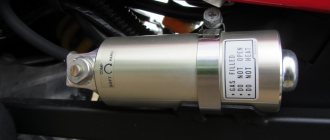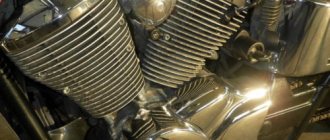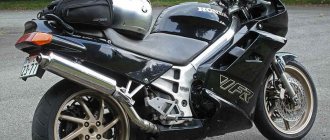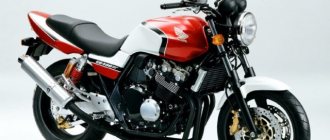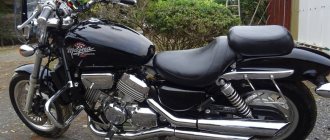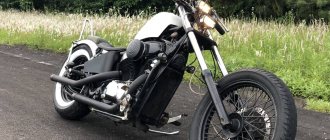Honda CB 400 is one of the most popular and best road bikes in the 400cc category. see in Russia.
The CB400 Super Four was first introduced to the Japanese market in 1992. It has been around for several generations. The differences mainly lie in the presence or absence of a VTEC system.
VTEC (Variable valve Timing and lift Electronic Control) is a system of dynamically variable valve timing, a proprietary development of Honda.
Regular Honda CB 400s were produced from 1992 to 1998, then they began producing “vtek” models.
Model overview
40 years of evolution and technical progress have given us today a fairly powerful, compact, beautiful and technically well-equipped middle-class motorcycle - the Honda CB 400 Super Four Hyper VTEC 4 versions REVO and BOLDOR.
The motorcycle is equipped with a 4-cylinder, 16-valve water-cooled engine with a displacement of 399 cm³. The car was created for the Japanese domestic market, because there are restrictions for beginner motorcyclists: the engine volume should not exceed 400 cm³, and the power should not exceed 53 hp. The engine is also equipped with an electronic injection system PGM-FI Fuel and a VTEC system.
VTEC works as follows: because the engine is 16-valve (4 valves per cylinder), then from 1st to 5th gear up to 6300 rpm only 2 valves per cylinder are used in the engine operation, the second pair of valves is activated above 6300 rpm and at a fully open throttle to increase power . In 6th gear, all 16 valves are engaged in engine operation.
The appearance of the motorcycle leaves no one indifferent - not only the driver gets pleasure from riding it, but also all passers-by turn around and follow this beautiful car with their eyes.
In terms of design, the motorcycle belongs to the “naked bike” class: it completely lacks plastic panels and fairings, the headlight is round, and the speedometer and tachometer are not covered in any way. The exception is the BOLDOR version: it is equipped with a front fairing and a square headlight .
The riding position on the motorcycle is classic, not sporty, so long-distance trips are not tiring, but for them it is better to have at least a little wind protection, or a BOLDOR version with a fairing: the motorcycle reaches a maximum speed of up to 190 km/h, which is quite a high figure, and At such speeds, drag increases greatly.
The motorcycle is very practical, has a relatively light weight, and is compact in size, making it well suited for dense city traffic and maneuvering between cars in traffic jams.
The motorcycle has a fairly powerful braking system - a large 2-disc brake at the front and a single-disc brake at the rear. The motorcycle has high dynamic characteristics - it accelerates to 100 km/h in 4.5 seconds.
All models of Honda motorcycles in the lineup have impressive characteristics, in each group of motorcycles by type.
Fuel consumption per 100 km in city mode is 4-8 liters, depending on the driver’s driving style.
The figures are so high because the CB400 engine is a modified CBR400RR engine. The modification consisted of increasing torque at low speeds and reducing fuel consumption compared to a sports motorcycle.
The design of the hero of our article is very close to English and resembles Triumph motorcycles. The model range can be found in our article.
The older brother from the Honda lineup was also not deprived of our attention, read here. Review of the motorcycle and its technical characteristics.
Bike features
Here are the main features of the machine:
- excellent vintage design and lack of plastic in the exterior;
- hard seat;
- Small dimensions, the motorcycle is not suitable for two.
The disadvantages of this bike in no way prevent the model from remaining one of the best retro classics at the budget level. Yes, there is a small design flaw in that the engine is made of gray aluminum, and it would have been much more correct for the manufacturer to make it chrome. But this is a minor minus.
Brief history of the model
- 1988 - start of production and sales of the Honda CBR 400 RR model, which replaced the Honda CBR 400 R Aero. This year's models have the Hurricane prefix on the lower side plastic. The first generation of the motorcycle. The frame number is NC23. The full model name is CBR400RR-J.
- 1989 - full model name - CBR400RR-K. The Hurricane prefix is removed from the plastic.
- 1990-1991 - second generation of the motorcycle. The frame number is NC29. The full model name is CBR400RR-L.
- 1992-1993 — full model name — CBR400RR-N.
- 1994 - full model name - CBR400RR-R. Starting this year, the model receives the Fireblade prefix at the top of the side plastic.
- 1999 is the last year of production of the Honda CBR 400 RR.
First generation: NC31.
1992-1998 – during this period, motorcycles were practically no different from each other. New configurations appeared: Version R (featuring a built-in plastic fairing and a square headlight) and Version S (featuring a classic round headlight, sporty carburetor settings, lack of a center stand, and 4-piston front calipers).
1992: Model: Honda CB400SF (Super Four); Frame number: NC31-100001 to NC31-1034643; Model code: CB400F IIn
1993: Model: Honda CB400SF (Super Four); Frame number: NC31-120001 to NC31-1212250; Model code: CB400F IIr
1994: Model: Honda CB400SF (Super Four); Frame number: NC31-130001 to NC31-1307373; Model code: CB400F IIs
1995: Model: Honda CB400SF (Super Four) Version R; Frame number: NC31-135001 to NC31-1354811; Model code: CB400F IIIs
1996: Model: Honda CB400SF (Super Four); Frame number: NC31-140001 to NC31-1401880; Model code: CB400F IIt
1996-1997: Model: Honda CB400SF (Super Four) Version S; Frame number: NC31-145001 to NC31-1456784; Model code: CB400F IIIt
1997: Model: Honda CB400SF (Super Four); Frame number: NC31-150000~; Model code: CB400F IIv
1997-1998: Model: Honda CB400SF (Super Four) Version S; Frame number: NC31-155000~; Model code: CB400F IIIv
Specifications
In terms of its parameters, this motorcycle is very good. Its performance even today is impressive and makes the model interesting for those who want to buy a cheaper motorcycle, but in good condition. This is a reliable car that has a very long service life, so even if it has been driving for more than a dozen years, its condition can be excellent.
Engine
The inline four shows good maximum performance: torque is 40 Nm and power is 53 hp. These are not such small figures for a unit with a volume of 399 cm³. The speed limit here is 190 km/h. For a small entry-level sportbike, you don’t need anything more powerful.
Class
| Classic 9 Sports 14 | Streetfighter 2 |
Engine capacity
docub. cm.
Transmission
The gearbox here is six-speed, and the drive is of a chain type. Thanks to this transmission, the Honda CBR 400 RR can accelerate well in any of the six gears. In addition, due to the type of drive, power is not lost when the motor potential transfers to the wheel.
Dimensions and weight
The motorcycle has average dimensions for the class: its wheelbase is 1375 mm, its height is 1080 mm, its length is 1990 mm, its width is 670 mm, and its seat height is 750 mm. The weight of the CBR 400 RR is 170 kg, and its tank volume is 15 liters. Fuel consumption greatly depends on driving style. In an aggressive sports race, up to 10 liters can be spent per hundred kilometers, while during quiet movement, about 5 liters can be spent.
Chassis and brakes
The frame of the bike is diagonal and made of aluminum. The latter circumstance makes the motorcycle lighter and much more in line with the sporty direction of the motorcycle than, for example, a steel one. The wheels are alloy and look very elegant, despite their simplicity.
At the rear, a progressive monoshock absorber is used as suspension. At the front, a 41 mm telescopic fork is used. The rear brake features a 220 mm disc along with a two-piston caliper, while the front uses a pair of 275 mm discs along with four-piston calipers.
Fuel consumption
The average fuel consumption of the Honda CBR 400 RR is 5-6 liters in quiet mode and up to 10 liters per 100 km in aggressive driving style.
Repair and service
This motorcycle is the most common, so there will be no problems with repairs and purchasing spare parts. Maintenance is quite inexpensive, but even with a little diligence and basic knowledge of technology, you can repair a motorcycle yourself.
Prices for spare parts and consumables are not high, with the exception of spark plugs. A set of sprockets and chain will cost about 6000-7500 rubles, an oil filter - 400-500 rubles, an air filter - about 500 rubles. The engine oil volume for the regular version of the CB400 when replaced with a filter is approximately 3.6 liters, and for the vtec version ~3.8 liters.
One of the known problems, like most Hondas, is a flying charging relay. This malfunction most often occurs due to a completely dead battery or poor contact (oxidation of the connector). To avoid charging problems and relay failure, it is recommended to constantly monitor the condition of the battery and periodically clean the connector itself.
Production
The motorcycle was produced from 1988 to 1999, which in itself speaks of its popularity. However, even after so many years, it continues to remain very relevant, especially if a person does not have much money, but the desire to purchase at least some kind of sports bike is enormous.
Technical characteristics of CBR400 R on nc23 frame
CBR400 Aero / CBR400 RRK
| Specifications/Models | CBR400RG (Aero) | CBR400 RH-Ya (Aero) | CBR400RRJ | CBR400RRK |
| Year of issue | 1986 | 1987 | 1988 | 1989 |
| Frame number from... / to... | NC23-1000027 | NC23-1015001 | NC23-1020011 | NC23-1090001 |
| NC23-1010690 | NC23-1016160 | NC23-1036454 | NC23-1098116 | |
| Engine number from... / to... | NC23E-1000042 | NC23E-1015002 | NC23E-1020001 | NC23E-1090001 |
| NC23E-1010736 | NC23E-1016192 | NC23E-1036510 | NC23E-1098123 | |
| Carburetor | VG02A-A | VG02A-E | VG04A-A | VG04B-A |
| L × W × H (mm) | 2015 × 685 × 1095 | 2020 × 690 × 1110 | ← | |
| Wheelbase (mm) | 1380 | 1370 | ← | |
| Ground clearance (mm) | 140 | 120 | ← | |
| Seat height (mm) | 765 | 765 | ← | |
| Weight / Dry weight (kg) | 184 / 165 | 179 / 162 | ← | |
| Engine capacity (cm3) | 399 | ← | ← | ← |
| Fuel consumption (km/l) | 43 (~60 km/h) | 38.1 (~60 km/h) | ← | |
| Diam. cylinder × piston stroke | 55 × 42 (mm) | ← | ← | ← |
| Compression ratio | 11:1 | 11.3:1 | ← | |
| Max. power (hp/rpm) | 59 / 12 500 | 59 / 12 500 | ← | |
| Max. torque (Nm/rpm) | 3.8 / 10 000 | 4 / 10 000 | ← | |
| Gas tank volume (l) | 16 | ← | 15 | ← |
| Gearbox (stages) | 6 | ← | ← | ← |
| Gearbox ratios: | ||||
| 1 | 3,307 | ← | ||
| 2 | 2,352 | ← | ||
| 3 | 1,875 | ← | ||
| 4 | 1,590 | ← | ||
| 5 | 1,434 | ← | ||
| 6 | 1,280 | ← | ||
| Suspension: | ||||
| Front fork | Telescopic, air-oil. Made by Showa | ← | ← | |
| Fork diameter (mm) | 41 | ← | ||
| Rear swingarm | Tri-Arm | ← | ||
| Brakes, number of pistons: | ||||
| Before | 2 | ← | ← | ← |
| Back | 1 | ← | ← | ← |
| Brakes, disc diameter (mm): | ||||
| Before | 275 | ← | ||
| Back | 220 | ← | ← | ← |
| Caster* / Track (mm) | 25° 15´/ 95 | ← | ||
| Tire sizes: | ||||
| Before | 100/80 R17 52H | ← | 120/60 R17 55H | ← |
| Back | 130/70 R18 63H | ← | 150/60 R18 67H | ← |
| Colors | Shasta white/red | Pearl crystal white/purple | Granite blue/black | Granite blue/silver |
| Shasta white/purple | Terra blue/white/red | Terra blue/white/red | ||
| Granite blue/silver | Seychelle night blue/white | Pearl crystal white/purple | ||
* Caster is the angle of inclination of the turning axis
Technical specifications of CBR400 RR on nc29 frame
CBR400 RRN / CBR400 RRR
| Specifications/Models | CBR400 RRL | CBR400 RRN | CBR400 RRR | |
| Year of issue | 1990 | 1992 | 1994 | |
| Frame number from... ~ to... | NC29-1000001 | NC29-1050001 | NC29-1100001 | |
| NC29-1010598 | … | … | ||
| Engine number from... / to... | NC23E-1300001 | NC23E-1420001 | NC23E-1500001 | |
| NC23E-1310636 | … | … | ||
| Carburetor | VP01A-A | VP01A-B | VP01B-A | |
| L × W × H (mm) | 1990 × 670 × 1080 | ← | ← | |
| Wheelbase (mm) | 1365 | ← | ← | |
| Ground clearance (mm) | 125 | ← | ← | |
| Seat height (mm) | 750 | ← | ← | |
| Weight / Dry weight (kg) | 179 / 162 | ← | 180 / 163 | |
| Engine capacity (cm3) | 399 | ← | ← | |
| Fuel consumption (km/l) | 35 (~60 km/h) | ← | 32 (~60 km/h) | |
| Diam. cylinder × piston stroke | 55 × 42 (mm) | ← | ← | |
| Compression ratio | 11.3:1 | ← | ← | |
| Max. power (hp/rpm) | 59 / 13 000 | ← | 53 / 13 000 | |
| Max. torque (Nm/rpm) | 4 / 10 000 | ← | 3.6 / 10 000 | |
| Gas tank volume (l) | 15 | ← | ← | |
| Gearbox (stages) | 6 | ← | ← | |
| Gearbox ratios: | ||||
| 1 | 3,307 | ← | ← | |
| 2 | 2,352 | ← | ← | |
| 3 | 1,875 | ← | ← | |
| 4 | 1,590 | ← | 1,578 | |
| 5 | 1,434 | ← | ← | |
| 6 | 1,318 | ← | ← | |
| Gear ratio | 2.117 / 2.600 | ← | ← | |
| Suspension: | ||||
| Front fork | Telescopic, air-oil. Made by Showa | ← | ||
| Fork diameter (mm) | 41 | ← | ← | |
| Rear swingarm | Gull-Arm | ← | ← | |
| Brakes, number of pistons: | ||||
| Before | 2 | ← | ← | |
| Back | 1 | ← | ← | |
| Caster* / Track (mm) | 24° 30´ / 91 | ← | ← | |
| Tire sizes: | ||||
| Before | 120/60 R17 55H | ← | ← | |
| Back | 150/60 R17 66H | ← | ← | |
| Colors | Fighting red/Pearl crystal white | Pearl crystal white/Dionysus blue | Ross white/Jockey blue | |
| Granite blue/Light silver | Pure black | Sparkle pearl black/Procyon red | ||
| Passion red/Heavy gray | ||||
| Granite blue/Heavy gray | ||||
* Caster is the angle of inclination of the turning axis
Honda CBR400RR (1990)
In 1990, an updated version of the CBR400RR model was released. The motorcycle had a standard fork, an aluminum frame and a reinforced aluminum swingarm, that is, everything that large sportbikes had, but in smaller sizes.
The modern lightweight frame has been designed to withstand heavy loads. The motorcycle's low weight and low seat also made it accessible to women. The most impressive feature of the new bike is the 14,500 rpm redline. However, maximum power is released at 13,000 rpm and amounts to 53 horsepower.
It should be noted that this is 6 horsepower less than in the original version of the motorcycle. Maximum torque is achieved at 10,000 rpm and is 39 Nm. The engine of the model is a 4-stroke 4-cylinder with two camshafts in the cylinder head and liquid cooling. Its working volume was 399 cubic meters. cm. The cylinder diameter was 55 mm and the piston stroke was 42 mm. The engine operated with a compression ratio of 11.3:1.
Fuel was supplied by four 26 mm constant vacuum carburetors. The maximum speed that the motorcycle was capable of reaching was 175 km/h. It had excellent handling thanks to the new adjustable telescopic fork and Showa rear swingarm suspension with adjustable gas-oil shock absorber.
Structural diagram
The motorcycle from Honda CB brand has a reinforced steel frame based on the Semi-double Cradle prototype. This made it possible not only to successfully install a 400 cc engine, but also to ensure good weight distribution of the car. The original design of the power unit mounting and good balancing made it possible to reduce vibration. The model has repeatedly won prizes at exhibitions and has earned positive reviews from consumers.
The layout of the CB and NT Bros motorcycles produced by Honda is the same: in front? telescopic fork with two coil springs, rear? classic pendulum with gas-filled shock absorbers and elastic elements.
Tuning the motorcycle suspension will allow you to achieve greater smoothness and better handling. To do this, pairs of shock absorbers and springs are selected that have the required technical characteristics. In the photos of devices that have undergone reconfiguration operations, there is a noticeable increase in ground clearance. Reviews from both beginners and experienced fans of fast driving are the most flattering.
The brake system of the Honda 400 CB SS series motorcycles, as well as the SV-1 and NT-400 Bros, is combined. This design is typical for sports bikes and is widely used by designers. Double disc brakes are installed on the front wheel, ? drums Tuning of this system is allowed only under the conditions of a specialized service and using original components. [ads-pc-2]
Photo gallery
As stated earlier, the Honda CB 400 motorcycle was released in 1975. Over the years, the appearance has changed several times. Looking at the first models and the more modern ones, it’s hard to say with confidence that this is the same motorcycle model. We bring to your attention a small selection of photos of Honda SB 400 from different years of production.
Sources
- https://themoto.net/moto/yaponskie/honda/cb-400.html
- https://motoli.ru/51-honda-cbr-400-cbr400rr.html
- https://chtocar.ru/moto/honda-moto/honda-cbr-400-rr.html
- https://moto.drom.ru/sale/+/Honda+CBR+400/
- https://www.cbr400rr.ru/articles/tehnicheskie_harakteristiki_cbr400rr.html
- https://moto.drom.ru/sale/+/Honda+CBR+400RR/?motoCondition%5B%5D=yes&motoDriveCondition%5B%5D=yes&query=Honda+CBR+400RR%2C+%D8%E8%ED%FB
- https://motoking.ru/bikes/moto/1703/CBR400RR_1990
Previous entry Motorcycle repair and maintenance
Next entry All-wheel drive motorcycle Ural. Why is it worth buying a Ural Gear Up motorcycle?
Third generation: NC42.
2008-2013 - Honda CB 400 is called Revo (Honda CB400SF Spec III Revo). Differences from versions 04-07. consist of color schemes, silver engine covers and rims. At the same time, a Boldor version with a front plastic fairing is being produced.
2014+ - The model receives an LED headlight and new aluminum 10-spoke wheels.
2008: Model: Honda CB400SF (Super Four), Honda CB400 Super Boldor, Honda CB400 Super Boldor (ABS), Honda CB400 Super Four (ABS); Frame number: NC42-100001~; Model code: CB4008, CB400S8, CB400A8, CB400SA8
2009: Model: Honda CB400SF (Super Four), Honda CB400 Super Boldor, Honda CB400 Super Boldor (ABS), Honda CB400 Super Four (ABS); Frame number: NC42-110001 to NC42-119999; Model code: CB4009, CB400S9, CB400A9, CB400SA9
2010: Model: Honda CB400SF (Super Four), Honda CB400 Super Boldor, Honda CB400 Super Boldor (ABS), Honda CB400 Super Four (ABS); Frame number: NC42-120001~; Model code: CB400A, CB400SA, CB400Aa, CB400SAa
2011: Model: Honda CB400SF (Super Four), Honda CB400 Super Boldor, Honda CB400 Super Boldor (ABS), Honda CB400 Super Four (ABS); Frame number: NC42-130001 to NC42-139999; Model code: CB400B, CB400Sb, CB400Ab, CB400SAb
2012: Model: Honda CB400SF (Super Four), Honda CB400 Super Boldor, Honda CB400 Super Boldor (ABS), Honda CB400 Super Four (ABS); Frame number: NC42-140001~; Model code: CB400C, CB400Sc, CB400Ac, CB400SAc
2013: Model: Honda CB400SF (Super Four), Honda CB400 Super Boldor, Honda CB400 Super Boldor (ABS), Honda CB400 Super Four (ABS); Frame number: NC42-150001~; Model code: CB400D, CB400Sd, CB400Ad, CB400SAd
2014: Model: Honda CB400SF (Super Four), Honda CB400 Super Boldor, Honda CB400 Super Boldor (ABS), Honda CB400 Super Four (ABS); Frame number: NC42-160001~
2015: Model: Honda CB400SF (Super Four), Honda CB400 Super Boldor, Honda CB400 Super Boldor (ABS), Honda CB400 Super Four (ABS); Frame number: NC42-170001~
2016: Model: Honda CB400SF (Super Four), Honda CB400 Super Boldor, Honda CB400 Super Boldor (ABS), Honda CB400 Super Four (ABS); Frame number: NC42-180001~

